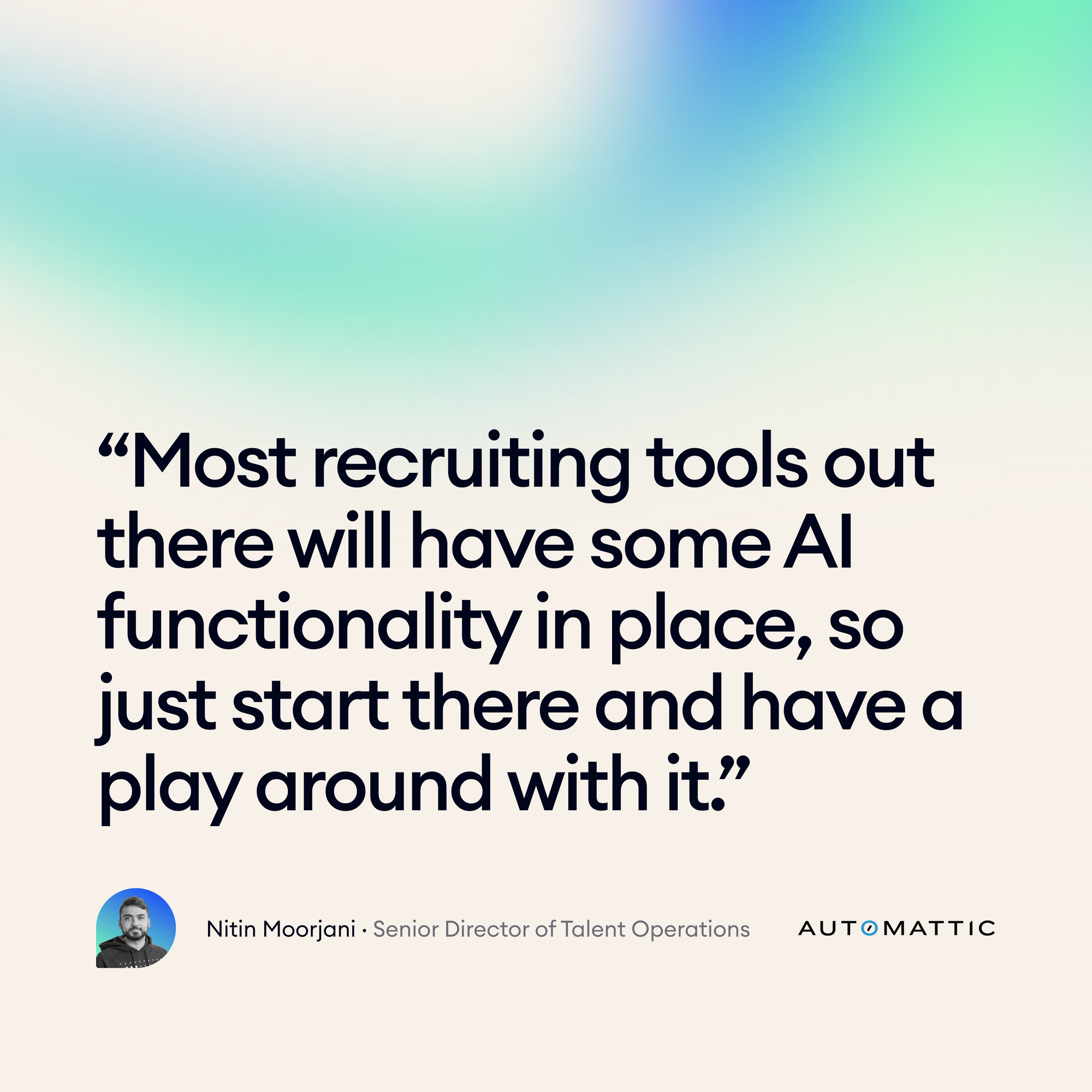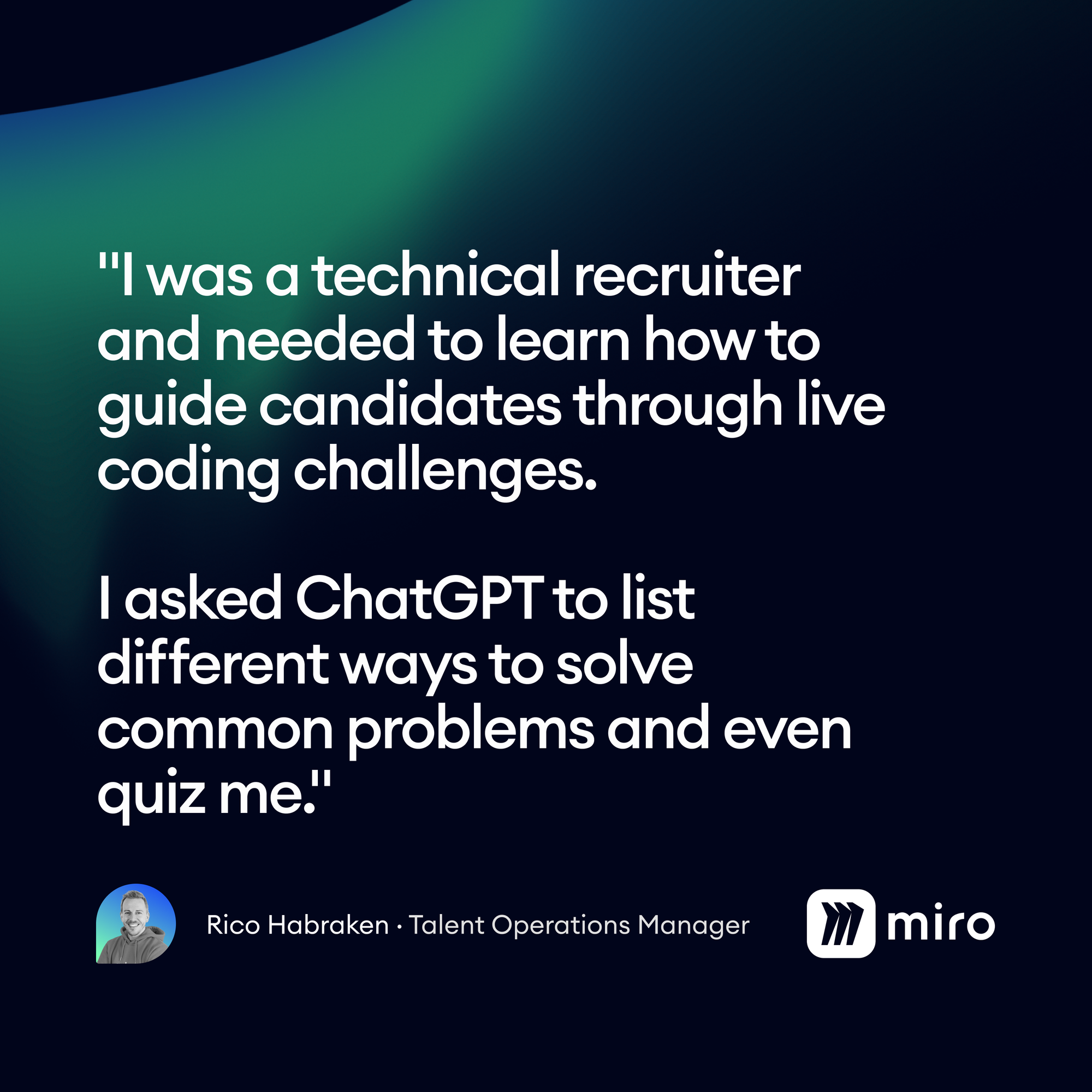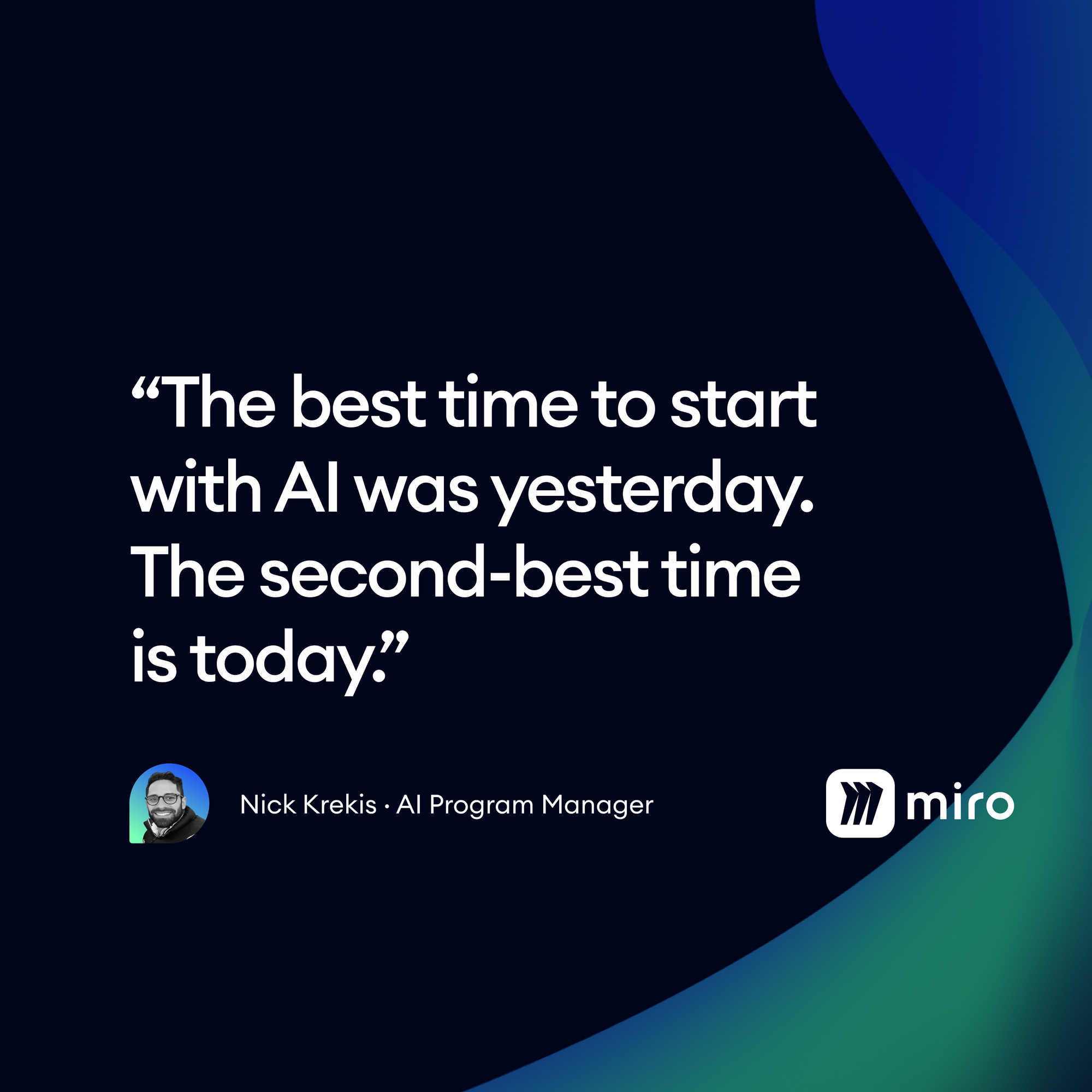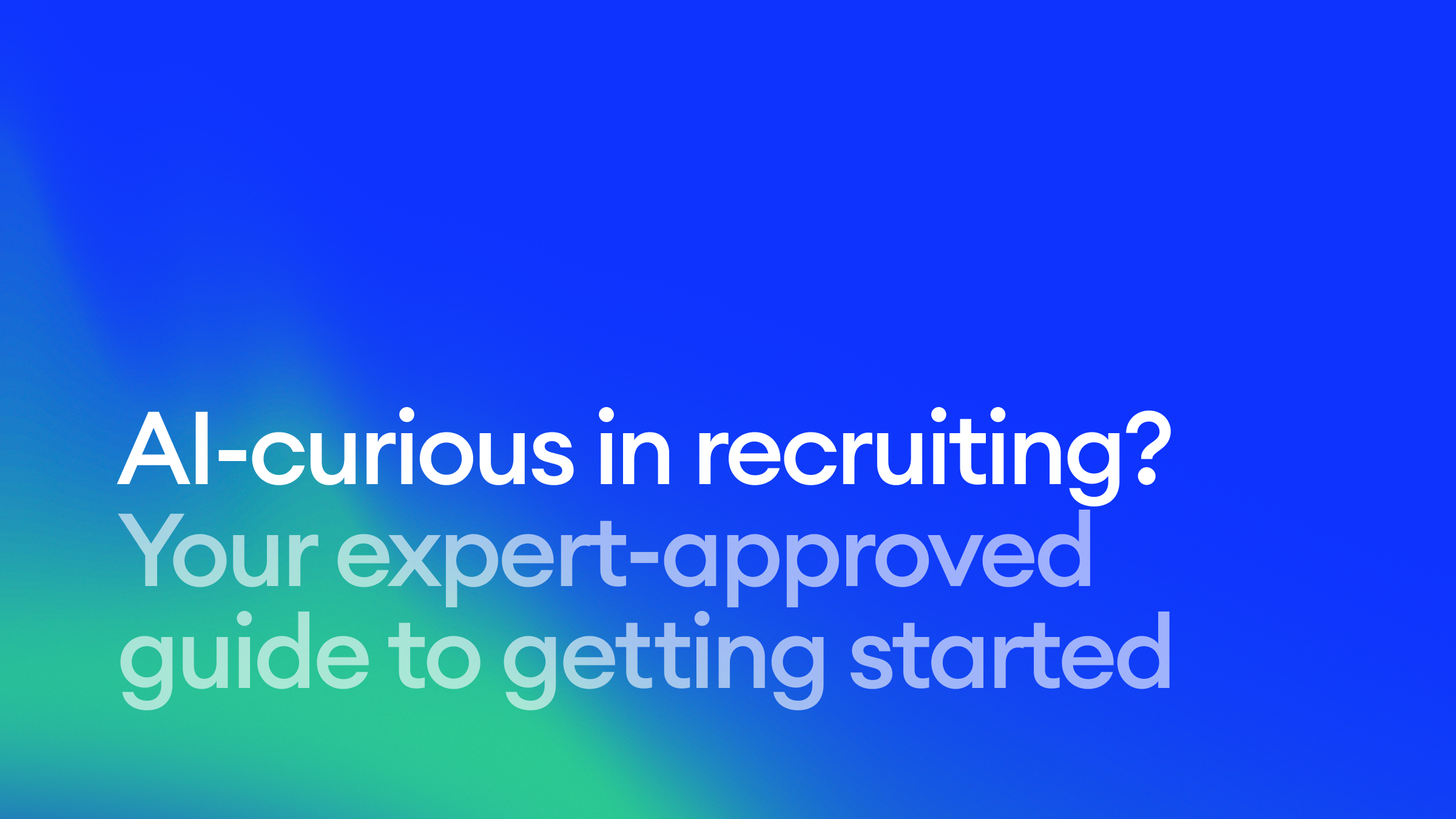Key takeaways:
- Start small by adding AI to your existing workflow instead of overhauling your approach.
- Focus on automating repetitive tasks that take time away from high-value recruiting work.
- No need to become an AI expert overnight — begin with a single use case and build from there.
"Learning about AI, figuring out how to apply it in your day-to-day, and suddenly upskilling yourself — it's overwhelming," says Nitin Moorjani, who leads Talent Operations at Automattic. "We've all had to figure it out on the go."
This feeling resonates with a lot of recruiters who might feel pressure to become AI experts overnight. But AI adoption isn't all-or-nothing — it's a gradual journey that unfolds over time.
"You don't need to master AI in a night," reassures Nick Krekis, AI Program Manager at Miro. "It's a journey that might take a year or two. The important thing is that you can't afford to ignore it."
Rather than replacing recruiters, AI is enhancing what they do best. AI is helping recruiters get back to what makes recruiting special. By handling administrative tasks, it frees up time for them to build deeper relationships with candidates and provide strategic counsel to hiring teams.
To help demystify AI adoption, we spoke with industry experts — Nitin from Automattic, Nick and his colleague Rico Habraken, who is the Talent Operations Manager at Miro, and our own Siadhal — to get their practical insights on how recruiters can kick off their AI journey with confidence. Their collective message is clear: start small, focus on existing workflows, and build from there.
Why start with AI now?
Falling behind on AI adoption has consequences. "Not inviting AI into your work is sort of rejecting innovation," says Nitin.
This isn't just about embracing the latest technology — it's about staying competitive. "AI is not going to replace you, but someone using AI will," Nick emphasizes.
Our most recent survey found that AI-enabled recruiters conduct 25% more interviews per week and spend 41% less time on documentation. The gap between those who use AI and those who don't is widening fast.
Siadhal puts it plainly: "Companies are going to be adopting this technology in order to improve performance as quickly as they can. And that means that people need to, as well. And the people that don't will be less effective."
First steps: Starting small
The journey toward AI mastery begins with what we can think of as the "crawl" stage. This isn't about revolutionizing your entire approach to recruiting — it's about finding small, low-risk ways to incorporate AI into what you're already doing.
Begin with existing tools that already have AI functionality
"Most recruiting tools out there will have some AI functionality in place," says Nitin. "So just start there and have a play around with it." Look at your current tech stack — your applicant tracking system (ATS), sourcing tools, or scheduling platforms — and check if they've recently added AI features. It's an easy way to experiment without having to learn entirely new systems.

Try an AI note-taker for interviews
When asked about the best place for recruiters to dip their toes in the AI pond, Nick recommends, "An interview note-taker for sure. It's a really easy, simple use case to just start getting familiar with something."
Nitin agrees, noting that his Automattic teammates "love the fact that they don't have to take notes anymore. They can recall information from interviews that sometimes they might miss."
AI note-taking tools like Metaview automate one of the most time-consuming parts of the recruiting process, a task that was never part of most recruiters' core job descriptions anyway.
"When I joined Uber as a product manager, despite doing a ton of interviewing and hiring, nowhere on the job description for that job — and frankly, nowhere even in how my performance was reviewed — was the quality of the notes that I wrote in my interviews," Siadhal points out. "It just wasn't actually part of the job, even though I spent a lot of time doing it."
Start with general-purpose AI tools for simple tasks
Nick recommends using tools like ChatGPT for basic tasks, like: "Here's a candidate’s CV. Can you cross reference their career history and experience with the specific requirements of the job description and highlight where there is good alignment."
Keep AI accessible
Rico from Miro suggests keeping AI tools visible and ready to use. He says if you’re working on a larger screen or second monitor, you can have one that is your workspace and the second where you have ChatGPT or another AI tool open." And then when you think of something or read something,” he says, “you can immediately act on it instead of wondering ‘Where do I start?’”
Practical uses for beginners
Once recruiters feel comfortable using AI, they can apply it to tasks that deliver immediate value.
Improve screening calls
Uploading a job description and CV into an AI tool can help recruiters have more effective screening calls with candidates. Nick shares that at Miro, recruiters use AI to quickly highlight areas to dig deeper into with candidates during screens.
Generate outreach messages to candidates
Miro has built an internal outreach generator that drafts two- or three-step candidate engagement sequences. Rico explains that it pulls in details from LinkedIn profiles or information about their background “which otherwise you’d have to manually adapt.” This approach streamlines outreach while maintaining personalization.
Summarize interview notes and feedback
AI tools can automate not only the entire note-taking process, but also help save time on submitting feedback. "They love the AI summaries," says Nitin of his team. "Our hiring managers and interviewers like it too. It's been really well-received. Everyone gets it."
Learn job-related skills
Rico describes using AI to improve his technical recruiting skills: "I was a technical recruiter and needed to guide candidates through live coding challenges. I asked ChatGPT to list different ways to solve common problems and even quiz me with multiple-choice questions."

Getting comfortable: Building your AI confidence
Getting comfortable with AI takes time, but small, consistent steps can make a big difference. Recruiters who build confidence gradually are more likely to see long-term impact. Here’s how to make AI a natural part of your workflow.
Start with one use case and build from there
Rico suggests a "habit stacking" approach: focus on one AI use case, repeat it until it becomes second nature, and then expand. This gradual adoption prevents overwhelm and builds confidence through small wins.
Expect imperfection — but see the bigger picture
Siadhal points out that AI tools may not always get things exactly right from the start, and that’s okay. He says, “You need to have a little bit of tolerance for mistakes from AI products, in general.” The goal is to focus on overall efficiency gains rather than occasional errors — this helps to maintain perspective.
Learn from your peers
Nitin recommends talking to colleagues who have already integrated AI into their workflow. Siadhal adds that freelance and boutique agency recruiters often explore AI first because their productivity depends on it. "They live and die by their personal or their team productivity. So their incentive to go and explore these things is really high.” These colleagues could be great resources to learn more about adopting AI.
For leaders: Introducing AI to your team
If you're leading a recruiting team, here are a few tips to guide your organization through early AI adoption.
Recognize that adoption levels will vary
Nick emphasizes meeting people where they are: "People go through change at very different paces and in very different ways.” Some people will eagerly embrace AI tools, seeing them as opportunities to streamline tasks and boost productivity, while others may be hesitant due to a lack of familiarity, concerns about job security, or resistance to change.
Model AI behavior to inspire team adoption
"We constantly talk about ways in which we use it, and we try to model that behavior so other people can be inspired to follow," says Nitin. "We don't only talk about specific recruiting AI stuff. We talk about how we work with ChatGPT,Claude, DeepSeek."
Consider both top-down and bottom-up adoption strategies
Siadhal has observed both approaches working. And what will fit for one specific team, he says, is “dependent on the culture of the company. I've been surprised by how many ICs taking initiative have been the agent for change and made it happen."

Looking forward: Your AI journey begins
As our research shows, 89% of recruiters cite time savings and increased productivity with AI — its true power lies in freeing them to do what matters most: building relationships and contributing to more informed decisions. As Nitin puts it, “Separating the AI to do the mundane tasks, that’s where it can really help. And then focusing your energy on building relationships with people.”
The sooner you integrate AI into your workflow, the sooner you’ll unlock its full potential. As Nick says, “The best time to start was yesterday. The second-best time is today.”
AI isn’t the future — it’s the present. Take the first step toward smarter recruiting — try Metaview for free today.


